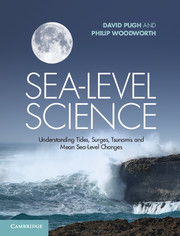Refine search
Actions for selected content:
5487 results in Thermal-fluids engineering

The Finite Element Method with Heat Transfer and Fluid Mechanics Applications
-
- Published online:
- 05 June 2014
- Print publication:
- 16 September 2013

Sea-Level Science
- Understanding Tides, Surges, Tsunamis and Mean Sea-Level Changes
-
- Published online:
- 05 May 2014
- Print publication:
- 24 April 2014
List of main symbols
-
- Book:
- Sea-Level Science
- Published online:
- 05 May 2014
- Print publication:
- 24 April 2014, pp xi-xii
-
- Chapter
- Export citation
Chapter 6 - Shallow-water and coastal tides
-
- Book:
- Sea-Level Science
- Published online:
- 05 May 2014
- Print publication:
- 24 April 2014, pp 133-154
-
- Chapter
- Export citation
Preface
-
- Book:
- Sea-Level Science
- Published online:
- 05 May 2014
- Print publication:
- 24 April 2014, pp vii-viii
-
- Chapter
- Export citation
Appendix A - Basic hydrostatic and hydrodynamic equations
-
- Book:
- Sea-Level Science
- Published online:
- 05 May 2014
- Print publication:
- 24 April 2014, pp 361-362
-
- Chapter
- Export citation
Appendix B - Currents
-
- Book:
- Sea-Level Science
- Published online:
- 05 May 2014
- Print publication:
- 24 April 2014, pp 363-367
-
- Chapter
- Export citation
Index
-
- Book:
- Sea-Level Science
- Published online:
- 05 May 2014
- Print publication:
- 24 April 2014, pp 389-395
-
- Chapter
- Export citation
List of acronyms
-
- Book:
- Sea-Level Science
- Published online:
- 05 May 2014
- Print publication:
- 24 April 2014, pp ix-x
-
- Chapter
- Export citation
Chapter 3 - Tidal forces
-
- Book:
- Sea-Level Science
- Published online:
- 05 May 2014
- Print publication:
- 24 April 2014, pp 36-59
-
- Chapter
- Export citation
Chapter 4 - Tidal analysis and prediction
-
- Book:
- Sea-Level Science
- Published online:
- 05 May 2014
- Print publication:
- 24 April 2014, pp 60-96
-
- Chapter
- Export citation
Chapter 2 - Sea-level measuring systems
-
- Book:
- Sea-Level Science
- Published online:
- 05 May 2014
- Print publication:
- 24 April 2014, pp 17-35
-
- Chapter
- Export citation
Appendix C - High and low water times and heights from harmonic constituents
-
- Book:
- Sea-Level Science
- Published online:
- 05 May 2014
- Print publication:
- 24 April 2014, pp 368-369
-
- Chapter
- Export citation
Chapter 12 - Sea-level applications
-
- Book:
- Sea-Level Science
- Published online:
- 05 May 2014
- Print publication:
- 24 April 2014, pp 318-344
-
- Chapter
- Export citation
Chapter 10 - Mean sea-level changes in time
-
- Book:
- Sea-Level Science
- Published online:
- 05 May 2014
- Print publication:
- 24 April 2014, pp 252-295
-
- Chapter
- Export citation
Contents
-
- Book:
- Sea-Level Science
- Published online:
- 05 May 2014
- Print publication:
- 24 April 2014, pp v-vi
-
- Chapter
- Export citation
Frontmatter
-
- Book:
- Sea-Level Science
- Published online:
- 05 May 2014
- Print publication:
- 24 April 2014, pp i-iv
-
- Chapter
- Export citation
Chapter 5 - Tidal dynamics
-
- Book:
- Sea-Level Science
- Published online:
- 05 May 2014
- Print publication:
- 24 April 2014, pp 97-132
-
- Chapter
- Export citation
Chapter 11 - Sea-level changes in time to do with the solid Earth
-
- Book:
- Sea-Level Science
- Published online:
- 05 May 2014
- Print publication:
- 24 April 2014, pp 296-317
-
- Chapter
- Export citation
Chapter 8 - Tsunamis
-
- Book:
- Sea-Level Science
- Published online:
- 05 May 2014
- Print publication:
- 24 April 2014, pp 189-222
-
- Chapter
- Export citation
